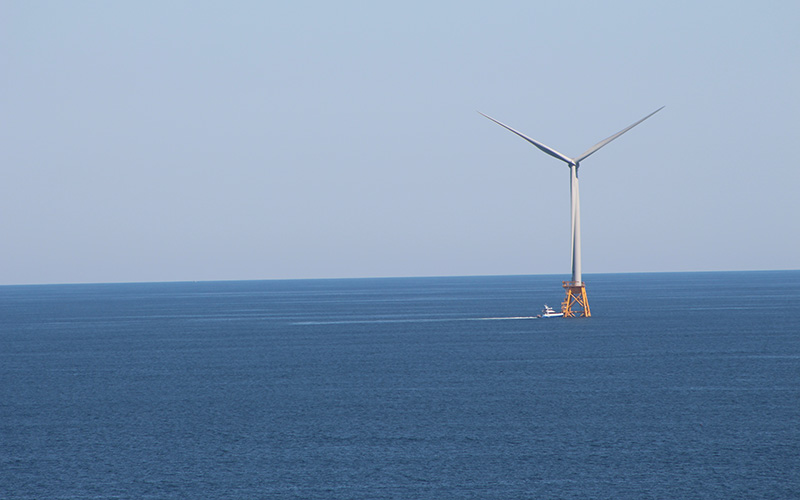
Offshore wind turbines are crucial to meeting New England's renewable energy goals. Photo: Laurie O'Reilly
Wind energy is an essential building block of New England’s clean energy future – one that’s good for our environment, protects our health, and creates good-paying jobs here at home. With offshore wind energy developed in the right way and in the right places, we can oust dirty, polluting fossil fuel from New England.
But the fossil fuel industry isn’t ready to give up its hold yet. They’re pushing back against offshore wind, twisting facts and spewing disinformation – often in the guise of local “grassroots” groups.
With so much misinformation swirling around, we’re laying out the facts you need to understand the future of offshore wind.
What is offshore wind?
Offshore wind turbines are tall structures that generate electricity when wind causes their long blades to rotate. Miles of cable carry the generated power under the seafloor to land. Once on land, the electricity is transmitted to onshore electric substations that distribute the electricity through the power grid to wherever it is most needed.
Why is offshore wind so important?
The climate crisis is already here – we see it in increasingly powerful storms, rising seas and soaring temperatures, massive forest fires, and shifting fish stocks. What’s more, New England and its oceans are warming faster than the rest of the country. That puts us at greater risk of extreme weather and more rapid sea level rise. Offshore wind may be our region’s best opportunity to replace burning polluting fossil fuels – the cause of climate change – with clean electricity. New England can’t meet our clean energy commitments without offshore wind.
Aren’t offshore wind and fishing inherently at odds?
No. Commercial fishing and offshore wind turbines can co-exist. Fishermen have legitimate concerns about access to fishing grounds and the impacts of wind turbines on habitat and species, which must be addressed. Some Indigenous groups also have expressed concerns about how wind development will impact their access to the water and its resources.
Developers and the fishing industry, including Indigenous representatives, must bring the best science, data, and local knowledge to the table and engage in open and honest dialogue early in the process. We’re already seeing this play out. For example, some wind companies have offered direct compensation to affected fishermen.
I read that offshore wind construction is killing whales. Is that true?
There is no evidence of whales being killed by offshore wind, and we cannot allow these lies to stand uncorrected. Citing so-called “research,” often provided by fossil fuel-funded think tanks, opponents of offshore wind are pushing the false narrative that the industry is killing whales. These opponents are co-opting the language of conservation and environmentalism to mask their opposition to renewable energy.
Why would people lie about wind turbines killing whales?
Many individuals and groups stalling offshore wind with lawsuits and disinformation are driven by concerns about views from oceanfront homes, while others are fronts for increased fossil fuel use. Some are both! Investigations have found that many “grassroots” groups are quietly receiving funding, resources, and even legal representation from fossil fuel interests. If we shut down offshore wind, we face a climate future of worsening floods, droughts, and other weather extremes. We also will condemn environmental justice neighborhoods to more years of living with polluting fossil fuel facilities just to protect the views of wealthy, white communities.
What is putting whales at risk?
Human impacts and climate change are the two greatest threats to whales. Entanglement in fishing gear and ship strikes are the leading causes of whale deaths. The ocean is warming at unprecedented rates due to climate change. This is threatening whales’ habitat as well as changing when and where right whales forage, putting them at increased risk.
Is there anything wind developers can do to mitigate any risks to whales?
Yes. Before projects get the green light, developers must take concrete steps to minimize the risk of harming whales. With speed limits of 10 knots or less, boats are far less likely to hit and seriously injure whales. In Europe, developers have dramatically reduced the number of boat trips to turbine construction sites by requiring some workers to be housed at them. Improving the monitoring and detection of whales, researching their habits, and implementing noise reduction technologies could also help offshore wind developers protect whales. These measures could help developers work to slow climate change while protecting the endangered whales who roam off our shores.
Several offshore wind projects have stalled or been canceled because of cost. What’s next?
Massachusetts, Connecticut, and Rhode Island governors are working to establish a consortium that should help make more projects in our shared waters affordable and competitive. Wind developers, representatives from the fishing industry, impacted Indigenous groups, environmental organizations, coastal communities, and other stakeholders should be at the table from the beginning to ensure these projects move forward as smoothly as possible.
Offshore wind is ready to replace fossil fuels. Already, the industry is reshaping some of our old port cities, providing new jobs, rehabilitating waterfronts, and training a new generation for promising careers with a strong economic future. We cannot let an increasingly well-funded campaign of disinformation and outright lies slow that down.



